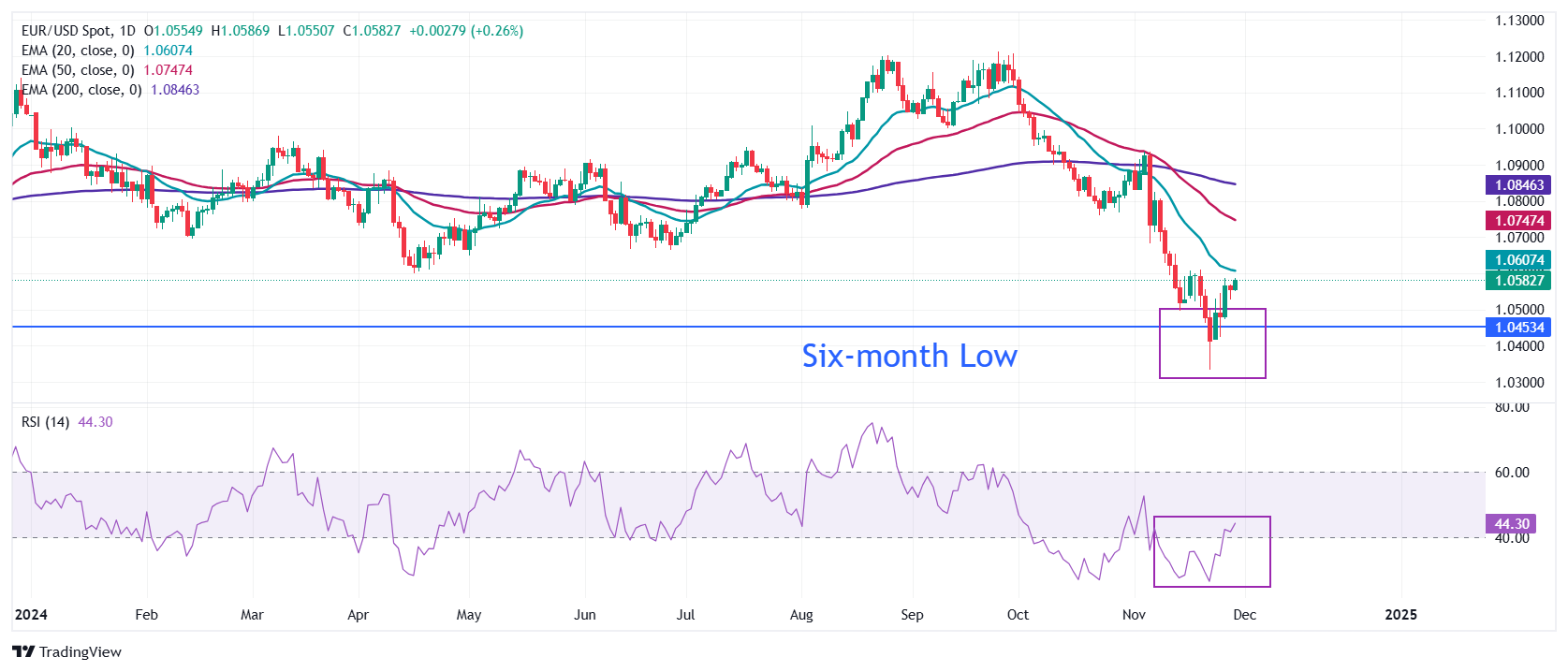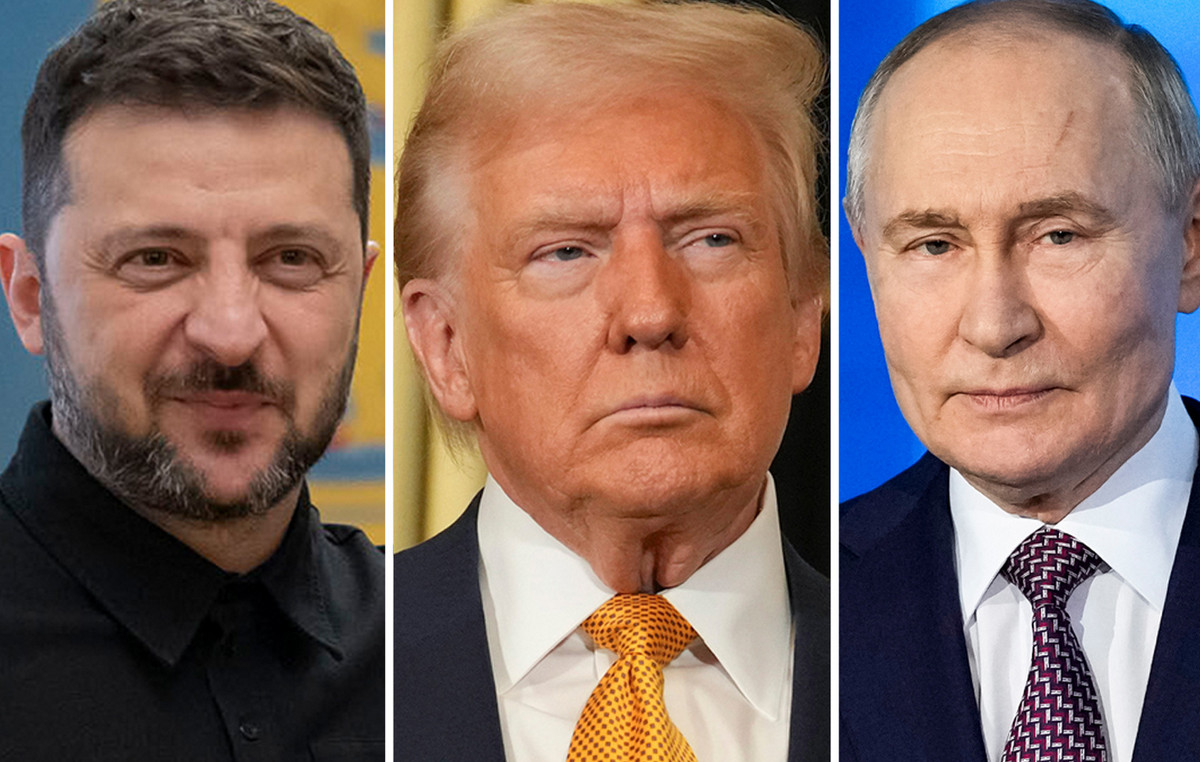- EUR/USD rises near 1.0580 as the US Dollar extends its correction.
- Investors await preliminary Eurozone HICP data for November, which will influence the outlook for the size of the ECB’s rate cut.
- ECB’s Villeroy keeps hopes of a bigger interest rate cut in December on the table.
EUR/USD marks a new weekly high near 1.0580 in the European session on Friday ahead of preliminary Eurozone Harmonized Index of Consumer Prices (HICP) data for November, due at 10:00 GMT. The inflation report is expected to show that annual headline and core HICP – which excludes volatile food and energy prices – accelerated to 2.3% and 2.8%, respectively.
Investors will pay close attention to the inflation report for new clues on the likely size of the European Central Bank’s (ECB) rate cut at its December meeting. The ECB has already reduced its deposit facility rate by 75 basis points (bps) to 3.25% this year.
Traders expect the ECB to cut its key interest rates by at least 25 bps at the December meeting. By 2025, traders see the ECB cutting interest rates at every meeting until June, taking the deposit facility rate to 1.75% by the end of the year, according to Reuters.
Market speculation about the ECB cutting interest rates by a larger-than-usual 50 bps is optimistic as officials are concerned about rising economic risks. The two largest economies in the Eurozone, Germany and France, are going through a difficult phase due to political uncertainty, a scenario that slows down government spending activities.
Additionally, weak German retail sales data for October points to economic stagnation. MoM retail sales contracted 1.5% after rising 1.2% in September. Economists expected retail sales data, a key indicator of consumer spending, to decline at a slower pace of 0.3%. On a year-over-year basis, the measure of consumer spending rose 1%, slower than estimates of 3.2% and the previous release of 3.8%.
ECB Governing Council member and Bank of France Governor François Villeroy de Galhau kept the option of a further interest rate cut on the table in his speech on Thursday. “Looking at today, there is every reason to cut on December 12. Optionality should remain open on the size of the cut, depending on incoming data, economic projections and our risk assessment,” Villeroy said.
Daily Market Summary: EUR/USD Advances as US Dollar Corrects Further
- EUR/USD gains ground as the US Dollar (USD) extends its decline in a holiday-shortened week. The US Dollar Index (DXY), which tracks the value of the Dollar against six major currencies, extends its correction below 106.00 on Friday. The USD Index began correcting on Monday after United States (US) President-elect Donald Trump nominated Scott Bessent, a veteran hedge fund manager, for the position of Treasury Secretary.
- Financial markets anticipated that Bessent would implement Trump’s economic agenda without disrupting foreign relations and fiscal discipline. “The goal of implementing tariffs will be “gradually and the budget deficit will be reduced to 3% of the Gross Domestic Product (GDP) by reducing spending, a measure that will not result in higher inflation than feared,” Bessent said in a interview with the Financial Times (FT) last weekend.
- On the monetary policy front, market experts expect the Federal Reserve (Fed) to be cautious with interest rate cuts as data from the underlying Personal Consumption Expenditure (PCE) Price Index, the indicator The Fed’s preferred inflation target accelerated in October. The probability that the Fed will cut interest rates by 25 bps to the 4.25%-4.50% range at the December meeting is 66%, while the rest support leaving them unchanged, according to the CME FedWatch tool.
- In the Friday session, the US Dollar is expected to remain sideways as US markets will open for limited hours due to the Thanksgiving holiday. For next week, investors should prepare for high volatility as a series of employment and economic data are released.
Technical analysis: EUR/USD rises near 1.0600
EUR/USD extends its rise near 1.0580 on Friday. The recovery in the major currency pair appears to be a mean reversion move, which could extend near the 20-day exponential moving average (EMA) around 1.0600. Still, the overall outlook would remain bearish as all short-term and long-term EMAs are declining, pointing to a downtrend.
The 14-day Relative Strength Index (RSI) rebounded after conditions turned oversold and rose above 40.00, suggesting that the bearish momentum has faded. However, the bearish trend has not died out.
Looking down, the November 22 low at 1.0330 will be key support for Euro bulls. On the other hand, the 50-day EMA near 1.0747 will be the key barrier.
The Euro FAQs
The Euro is the currency of the 19 countries of the European Union that belong to the eurozone. It is the second most traded currency in the world, behind the US dollar. In 2022, it accounted for 31% of all foreign exchange transactions, with an average daily turnover of more than $2.2 trillion per day. EUR/USD is the most traded currency pair in the world, accounting for an estimated 30% of all transactions, followed by EUR/JPY (4%), EUR/GBP (3%) and EUR/AUD (2 %).
The European Central Bank (ECB), headquartered in Frankfurt, Germany, is the reserve bank of the eurozone. The ECB sets interest rates and manages monetary policy. The ECB’s primary mandate is to maintain price stability, which means controlling inflation or stimulating growth. Its main tool is the increase or decrease in interest rates. Relatively high interest rates (or the expectation of higher rates) tend to benefit the euro and vice versa. The Governing Council of the ECB makes decisions on monetary policy at meetings held eight times a year. Decisions are made by the directors of the Eurozone’s national banks and six permanent members, including ECB President Christine Lagarde.
Eurozone inflation data, measured by the Harmonized Index of Consumer Prices (HICP), are an important econometric indicator for the euro. If inflation rises more than expected, especially if it exceeds the ECB’s 2% target, it forces the ECB to raise interest rates to bring it back under control. Relatively high interest rates compared to their counterparts tend to benefit the euro, making the region more attractive as a place for global investors to park their money.
The published data measures the health of the economy and may have an impact on the euro. Indicators such as GDP, manufacturing and services PMIs, employment and consumer confidence surveys can influence the direction of the single currency. A strong economy is good for the Euro. Not only does it attract more foreign investment, but it may encourage the ECB to raise interest rates, which will directly strengthen the euro. Otherwise, if economic data is weak, the Euro is likely to fall. Economic data for the four largest eurozone economies (Germany, France, Italy and Spain) are especially significant, as they represent 75% of the eurozone economy.
Another important data that is published about the Euro is the trade balance. This indicator measures the difference between what a country earns from its exports and what it spends on imports during a given period. If a country produces highly in-demand export products, its currency will gain value simply from the additional demand created by foreign buyers seeking to purchase those goods. Therefore, a positive net trade balance strengthens a currency and vice versa in the case of a negative balance.
Source: Fx Street
I am Joshua Winder, a senior-level journalist and editor at World Stock Market. I specialize in covering news related to the stock market and economic trends. With more than 8 years of experience in this field, I have become an expert in financial reporting.








